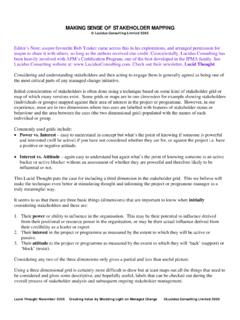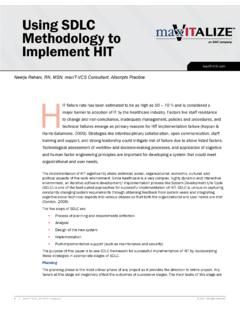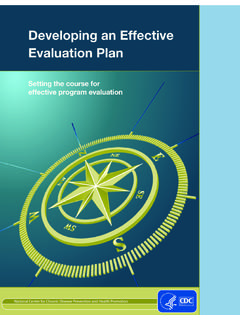Transcription of Program Design Beyond the Bell - boostconference.org
1 Beyond the bell at American Institutes for Research Tool 41 | Page 1 41 Program Plan Template Directions: In crafting your Program plan, use the Program Plan Checklist below to ensure that you have covered all possible sources of information. You may not be ready to include all of the sections listed here. Start with the information you have and add more as you go along. Try to be as comprehensive as possible. You may want to use a written report format, create a binder with dividers for each topic, or organize the information into a PowerPoint presentation. Choose a format that makes sense for you and your stakeholders. If you choose to compile your plan in a written format, you may use the sections for various purposes in the future ( , grant writing, writing an evaluation report).
2 Program Plan Checklist Title x Name of the Program and organization x Title of the Program x Names (and organizations, if external) of the individual stakeholders involved in the planning process Comment: Avoid the use of acronyms in the title page. Table of Contents x Provide sufficient detail to guide the reader through the report, including page numbers. x Include boxes, figures, tables, and appendices. Executive Summary x State the vision for the Program and the theory of change (if the theory of change is a visual only, do not include). x Define the Program goals and activities. x Describe the Program planning activities (asset mapping, market analysis, needs assessment).
3 X Summarize the key Program activities and partners. Comment: The executive summary should serve as a stand-alone component of the Program plan because intended users of the plan may refer to the summary rather than the larger document. The executive summary should not include any information that is not covered in the report. Program Vision and Theory of Change x This section should clearly state the vision for the Program and the theory of change. Comment: If the theory of change is primarily a visual representation, provide a brief narrative describing the thinking behind it, including citations of any relevant literature/research. Beyond the bell at American Institutes for Research Tool 41 | Page 2 Background/ Supporting Information x Briefly outline the literature base/research in the field of afterschool and expanded learning, stating the benefits of such programs .
4 Hint: The references for this Toolkit should provide you with a good start! x If you are targeting a certain content area ( , STEM), make sure to include a sentence or two on the importance of that content area and the literature/research that supports it. x Describe the context of the Program . This should include the community characteristics, the local school(s), and any relevant information about local assets, family information, and other local programs . Source: market analysis and/or asset map. x Explain how the idea for Program originated, relating this to the organization s mission, Program vision, and population needs. Make sure to support this presentation with research literature and community needs assessment findings where possible.
5 X State the demand, gap in the field, or interest in the Program . Source: market analysis, asset map, and needs assessment. Goals, Action Steps, and Outcomes x State clearly each of your Program goals. x Under each Program goal, detail the action steps you will take to achieve the goal. x The action steps should be practical and specific, and they should identify who is responsible for the action. x You may choose to associate a timeline or start and end dates with your action steps. x State the intended outcome for each goal. Comment: If you have a Program logic model, you should include this here, making sure to explain the elements in detail. Program Structures, Reach, and Partners x Describe the scale of the Program , detailing the size and details of the target population (grades, ages).
6 X Describe the Program setting. This should include both the space for the Program and the time of year and day it is offered. x Identify and describe the key partners that collaborate with your organization in the delivery of the Program . Source: asset map. Organizational Capacity Statement and Fundraising Plan x Describe the Program s resource capacity, providing details of the total human resources ( , staffing plan) and financial budget supporting the Program . x Describe any fundraising activities planned for the year to earn revenue. Beyond the bell at American Institutes for Research Tool 41 | Page 3 Evaluation Plan x Clearly state the evaluation questions and tie the questions to the following bullets: Describe the types of data that you will collect (quantitative, qualitative, or mixed).
7 Describe who you will collect information from ( , Program participants, staff, community members, stakeholders) and how these individuals will be selected to participate in the evaluation. Explain what data collection tools you will use, how they were chosen, and how the data produced is intended to answer the evaluation questions. Explain how stakeholders will participate in the evaluation. Explain the ethical considerations you are taking into account when conducting the evaluation. Make sure to explain how you are protecting the confidentiality of respondents. Comment: It is ideal to think about the evaluation plan at the beginning of the Program Design phase, using your logic model.
8 However, you may not feel ready to do this yet. This section can be added later, but don t wait too long because the earlier you plan your evaluation activities, the easier it is to seamlessly integrate them into your Program . Conclusions, Challenges, and Recommendations x Conclusions should summarize the Program plan into one comprehensive paragraph. x The challenges should outline for the reader practical problems to the execution of the plan and recommended solutions to that challenge. For example, a challenge may be that the contract for programming needs to be executed before the school year begins so that the organization can take the appropriate time required to hire skilled staff.
9 Appendices x Summary findings from the market analysis, asset mapping, and needs assessment x Blank tools (surveys, interview protocols) that were used to conduct the market analysis, asset mapping, and needs assessment x Lists of individuals interviewed, including position titles x Sample monthly planners, or any tool that illustrates the Program clearly for the reader References x A comprehensive list of sources, including documents reviewed. Beyond the bell at American Institutes for Research Tool 37 | Page 1 37 Goal Setting Worksheet Directions: This worksheet can be used to record both goal areas and specific goals. First, write down the vision statement you created with your stakeholders.
10 Do not attempt to create goals without first knowing your vision. Next, think about the areas in which you want to set goals. Record these in the column on the left. A few examples are provided to get you started. Then, in the middle column, record your specific goals for each area. Make sure your goals support your vision. Use the third column to indicate a timeline for achieving each goal ( , this month, this Program year, within two years, etc.). Finally, use the last column to make notes about your goals for example, you might include specific staff members tasked with overseeing the goal or notes on partnerships or resources that can help you accomplish the goal. Goal Setting Worksheet Example Vision Statement Goal Areas Specific Goals Timeline Activities/Notes Programming Ensure programming integrates youth development principles.










